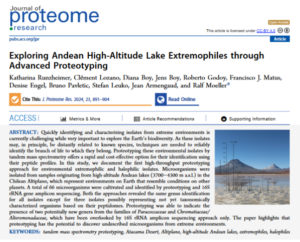On February 20, 2024, a publication by the DLR project members Prof. Dr. Ralf Möller and Katharina Runzheimer, along with their collaborators from Germany, France, and Chile, appeared in the Journal of Proteome Research. The study focuses on the cultivation and subsequent identification of extremophilic microorganisms from five different high mountain lakes (>3700 meters above sea level) in Chile. Characteristic features of the lakes included highly diverse salt concentrations of up to 27%.
Using creative as well as conventional cultivation approaches, 66 different, partially halophilic isolates were obtained. The isolates were identified using DNA-based methods such as 16S rRNA sequencing, as well as protein-based methods such as tandem mass proteotyping. Half of the isolates showed a similar species as the closest related organism using both methods. However, the two methods partially categorized different isolates as new species or genera. It was demonstrated that the protein-based identification method identifies isolates as new genera that were not classified as novel genera by the standard 16S rRNA method. The paper showed that proteoyping is a useful method to characterize and identify isolates from extreme environments.
Link to the paper: Exploring Andean High-Altitude Lake Extremophiles through Advanced Proteotyping | Journal of Proteome Research (acs.org)

